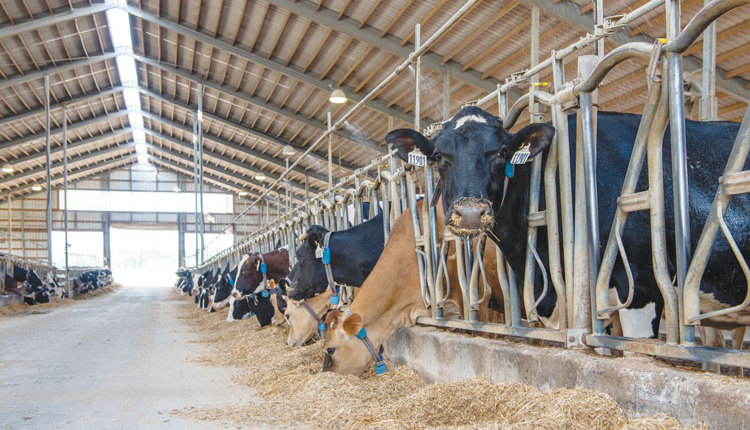The author has a dairy nutrition consulting business, Paradox Nutrition LLC, in Plattsburgh, N.Y.

Sugar alcohols are similar to sugars except that they have an extra hydrogen atom forming what is chemically called an alcohol group (-OH). Sugar alcohols do not contain ethanol as in alcoholic beverages, and can be made from sugars and starch. They are used as sugar substitutes in foods, primarily because they do not cause sudden spikes in blood sugar for people with diabetes. Glycerol, sorbitol, and mannitol are all examples of sugar alcohols.
Glucose is the main sugar in blood and the main energy source for the cells in the body. The chemical formula for glucose is C6H12O6, which consists of six carbon
atoms, 12 hydrogen atoms, and six oxygen atoms. Much of the carbohydrates fed to cows are broken down into glucose and either used by the rumen microbes or directly by the cow.
Sugar alcohols fed to cows can also be changed into glucose. Glycerol, also known as glycerin, is a natural component of fats and oils. It is a by-product of biodiesel production. Sorbitol and its isomer, mannitol, are naturally found in many fruits and vegetables.
Subclinical ketosis
With higher energy demands at calving and limited dry matter intake, most cows begin to take some fat off their back and convert that fat into nonesterified fatty acids (NEFA), which can be found in blood. In the liver, NEFA is then converted to energy and acetate. If propionate is available at the liver, the acetate is also converted into energy for the cow. If not, the acetate is converted into ketones, which can depress the cow’s intake. Blood beta-hydroxybutyrate (BHB) levels will indicate a cow’s metabolic response to a negative energy balance situation where fat is being mobilized.
A greater propionate supply can help to reduce subclinical ketosis. Propionate is produced by the rumen microbes mainly from the fermentation of starch. Adding dry matter intake through transition cow management can boost available propionate, and avoiding issues like milk fever and metritis can benefit intake.
Adequate dietary starch is also important for propionate production, but excessive starch can compromise rumen function and depress feed intake. Propionate salts fed at a rate of 0.25 pound per cow per day have improved intake and production as well as reduced blood NEFA levels in early lactation cows.
Improved performance
Sugar alcohols fed at 0.22 to 0.33 pound per cow per day has shown improved transition cow performance. Unlike dietary sugars, sugar alcohols are primarily fermented to propionate. Sugar alcohols can be used as a partial, alternative energy source for dairy cows to improve glucose status in transition cows. Sugar alcohols can also be converted to lactose, the primary milk sugar, to improve milk yield.
Researchers at the University of Illinois fed sugar alcohols at 0.22 pound per cow per day for 14 days to 50 cows before calving on a commercial dairy. An additional 50 cows received no treatment. During the first 98 days of lactation, cows fed sugar alcohol before calving produced 4.5 pounds more milk than the control group. Dry matter intake was not measured in this study. The researchers found no change in blood glucose, BHB, or NEFA levels, which were checked at one and seven days after calving.
Recently, scientists at University of Minnesota fed a commercial pellet to provide 0.275 pound of sugar alcohol per cow per day from calving day until 30 days after calving. This study was conducted on a commercial robot-dairy with 219 cows. Cows either received the sugar alcohol via a commercial pellet fed at the milking robot in addition to their normal feed or they received only their normal feed as the control. During the first 30 days after calving, mature cows fed sugar alcohol produced 7.75 pounds more energy-corrected milk per day than control cows. After the 30 days of sugar alcohol supplementation, these cows still produced 4.75 pounds more energy-corrected milk per day than control cows over the next 60 days. Intake of the partial mixed ration (PMR) was not measured in this study, so it is not known if cows supplemented with sugar alcohol ate more or less. First-lactation cows fed sugar alcohol did not produce more energy-corrected milk. Blood samples taken between four and 10 days in milk and between 24 and 30 days in milk had an average BHB concentration below 1.2 mmol/L, indicating little subclinical ketosis. BHB levels were not affected by sugar alcohol supplementation.
Why didn’t we see a milk response in the first lactation cows in the Minnesota study? I’m not sure. But, first-lactation cows generally have a lower ketosis risk. Also, there were fewer first-lactation cows in the study, which may not have helped the statistics.
Why do we see positive milk responses when feeding sugar alcohols but we don’t see expected positive responses in blood parameters? Perhaps with more frequent blood sampling and more cows in studies, we would see differences. Most likely, we also do not fully understand the mechanisms of action involved in producing the milk response. Hopefully future research will help us out.
Heat stress mitigation
Heat-stressed cows can have reduced dry matter intake and milk production and experience other health issues, including loss of body fat. Researchers at the University of Missouri conducted a study with 48 mid-lactation cows using chambers to create a thermoneutral environment for six days and then a heat-stress environment for 12 days. Cows were fed either sucrose or a sugar alcohol at a rate of 0.22 pound per cow per day. Under heat stress conditions, cows supplemented with sugar alcohol consumed 3.5 pounds of more dry matter per cow per day, produced 3.6 pounds more milk per cow per day, and tended to have lower plasma NEFA levels, indicating that they were not using as much body fat to meet their energy needs.
If you are thinking about including sugar alcohols in your cows’ diet to improve transition cow success or fight heat stress, talk with your nutritionist. Consider ways to target this type of additive only to the cows that need it most and will respond the best for the greatest return on investment. Then, work hard to truly evaluate cow response on your dairy.










